Observing: RW Tauri Eclipsing Binary Star;
Imaging: Orion Nebulae, Pleiades, Andromeda Galaxy
Posted: 19 January 2017
After my last session on Thursday, 12 January 2017, cloudy skies continued until Wednesday evening, 18 January. There was a brief thunderstorm Saturday morning, 14 January. One of my webcams captured this lightning:

Received 0.22" rain on Saturday, 1.01" on Sunday, 15 January, and 0.08" on Monday, 16 January. The sky started mostly clear during the day on Tuesday, 17 January, but clouds began showing up mid-morning, becoming mostly cloudy by mid-afternoon. Even had a surprise brief thunderstorm late in the afternoon (0.22" rain) and a triple rainbow!
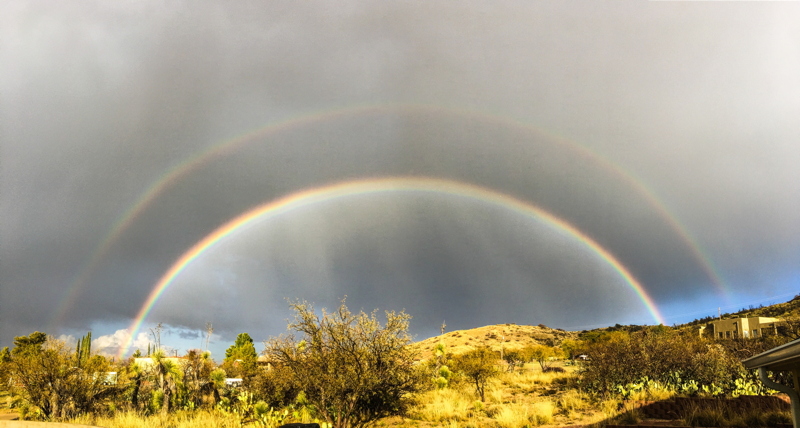
Click or tap on image for larger version
|
Open: Wednesday, 18 January 2017, 1809 MST Temperature: 60°F |
Session: 1060 Conditions: Mostly clear |
Equipment Used:
12" f/8 LX600 w/StarLock
Wired AutoStar II handset
2" 24mm UWA eyepiece
2" 2X PowerMate
Camera:
D7200 DSLR
After opening the observatory I SYNCed the observatory clock to WWV.
1815 MST: LX600 ON, StarLock OFF, High Precision OFF.
Viewed the planet Venus, 102X. Slightly less than half-phase was visible.
Then slewed the 12" telescope to the star Aldebaran and SYNCed the AutoStar. 1821 MST: slewed to the eclipsing variable star RW Tauri and began observing it, 102X. Mid-eclipse would occur at 2120 MST. The star was still at Magnitude +8, but would drop to the much fainter Magnitude +11.5 during the eclipse.
1830 MST: began setting up the LXD55 GEM for sky photography with the D7200 DSLR and 70-300mm lens:
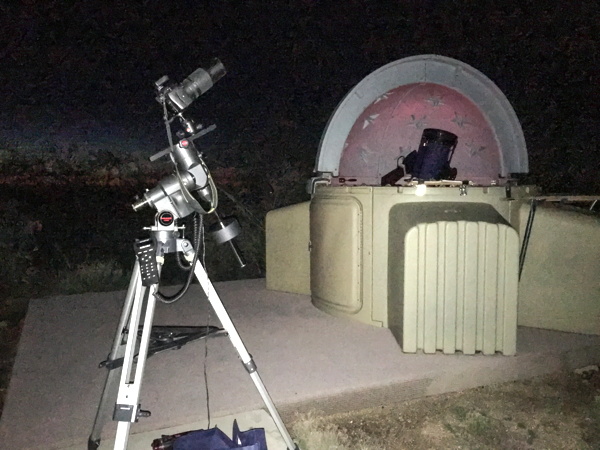
1848 MST: resumed observing RW Tauri. 1851 MST: moved the observatory dome onto the POD Zenith Table (PZT) in order to continue observing RW Tauri as it approached the zenith.
1905 MST: began preparing for sky photography. Set the DSLR lens focus using the Gerd Neumann Bahtinov Mask for Camera Lens. Polar aligned (approximately) the LXD55 GEM and then powered it ON. Did an Easy AutoStar Alignment. Began sky photography with the Orion Nebula (M42). This is an f/5.6, 1 minute, ISO 5000, White Balance 4000K, FL 300mm, image showing the Orion Nebula with the Running Man Nebula (NGC1977) to its left:
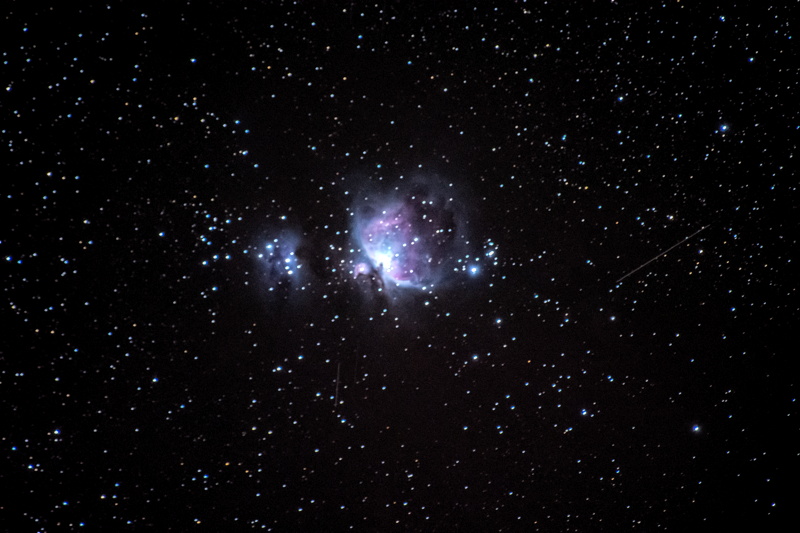
I decreased the focal length to 185mm for this f/5, 2 minutes, ISO 5000, WB 4000K, of Orion's belt and sword showing the Orion Nebula, Running Man Nebula, Flame Nebula (NGC2024), the Horsehead Nebula, and two faint satellites:
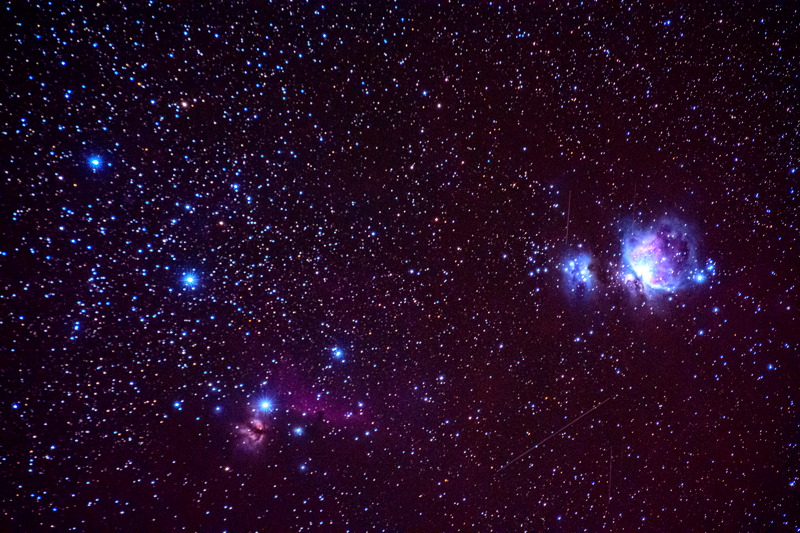
Mouseover or tap on image for labels
The Pleiades (M45), f/5.6, 2 minutes, ISO 5000, WB 4000K, FL 300mm:
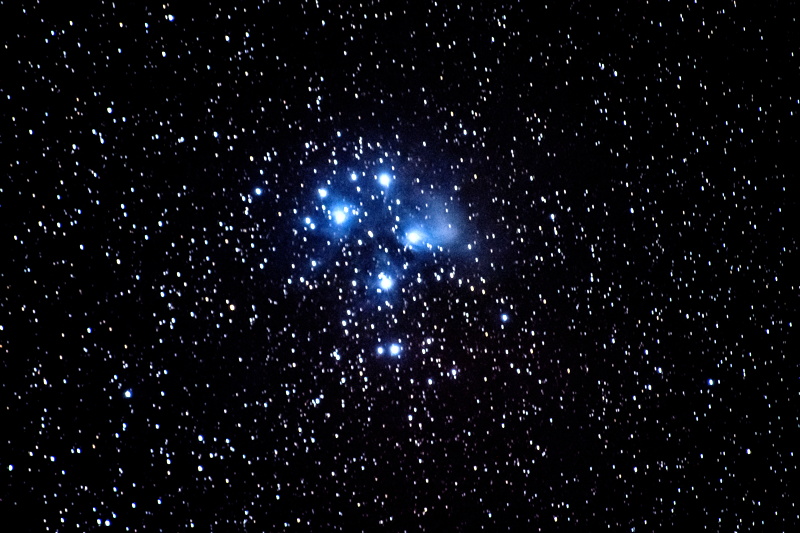
Andromeda Galaxy (M31) and its two companion galaxies M32 (above and left) and M110 (below), f/5.6, 2 minutes, ISO 12800, WB 4000K, FL 300mm (slightly cropped):

2001 MST: ended sky imaging. Resumed observing RW Tauri with the 12" telescope, 102X. It was definitely dimmer now. 2012 MST: RW Tauri magnitude estimate +11. 2035 MST: estimated Magnitude +11.5. Continued observing RW Tauri. 2120 MST: mid-eclipse; definitely Magnitude +11.5 now.
As I continued observing the star RW Tauri, the humidity was increasing. Papers were getting damp.
2139 MST: RW Tauri getting a little brighter. Some thick clouds began appearing in the southern sky. 2200 MST: RW Tauri continued to brighten. Decided to stop observing RW Tauri and do some astrophotography with the 12" telescope before the clouds interferred.
Viewed M43 (part of the Orion Nebula), 102X. Then slewed to Rigel, which would be the focus star. Mounted the DSLR at prime focus + 2X PowerMate and focused using the Astrozap mask. SYNCed the AutoStar, then slewed to the Trapezium star cluster in M42. 2212 MST: StarLock ON (for autoguiding). The four stars of the Trapezium are visible at the center of this 30 seconds, ISO 1600, WB Auto, image:
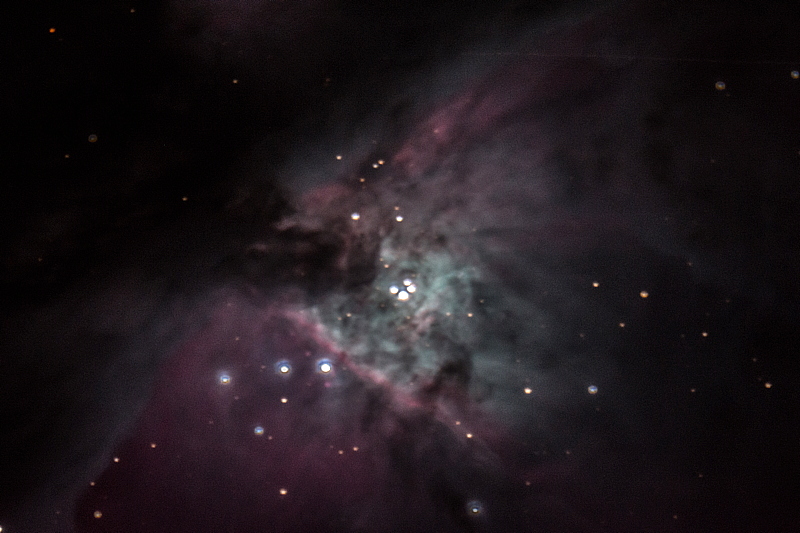
(Halos around brighter stars are optical artifacts from the PowerMate.)
Then slewed to M43 for this image, prime focus + 2X PowerMate, 2 minutes, ISO 6400, WB Auto:
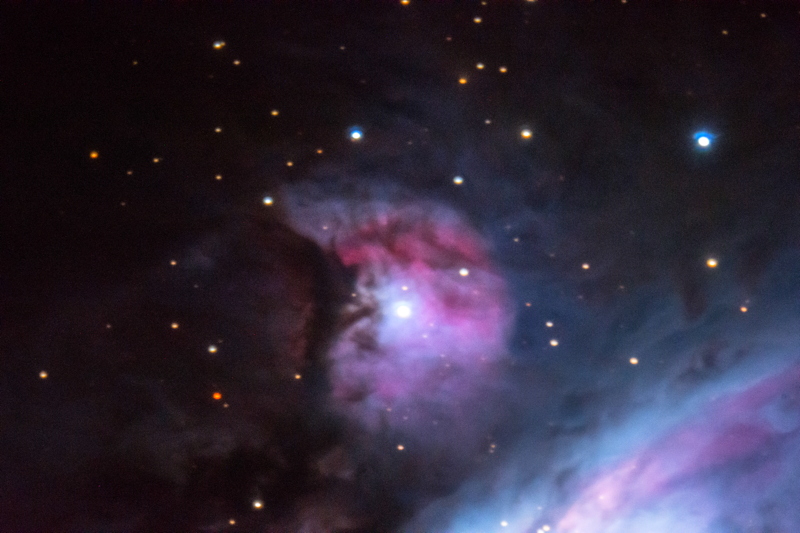
2237 MST: ended imaging. StarLock OFF.
Viewed M42 (Orion Nebula), 102X. Then took a last look at RW Tauri, 102X. Almost back to Magnitude +8. I hope to image the eclipse at the next favorable opportunity (29 January).
2246 MST: LX600 OFF. Moved the dome back onto the observatory.
|
Close: Wednesday, 18 January 2017, 2302 MST Temperature: 41°F |
Session Length: 4h 53m Conditions: Mostly clear, breezy, high humidity |
Comments are welcome using Email. Twitter users can use the button below to tweet this report to your followers. Thanks.
Cassiopeia Observatory Home Page
Copyright ©2017 Michael L. Weasner / mweasner@me.com
URL = http://www.weasner.com/co/Reports/2017/01/19/index.html
